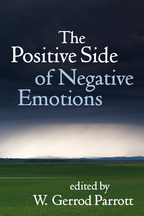The Positive Side of Negative Emotions
Edited by W. Gerrod Parrott
Hardcovere-bookprint + e-book
Hardcover
orderJanuary 27, 2014
ISBN 9781462513338
Price: $57.00304 Pages
Size: 6" x 9"
“Superbly edited by a prolific researcher and leader in the field of emotion research….The contributions…are notable for the diverse, fine-grained analyses of emotion regulation they present….Highly recommended. All readers.”

—Choice Reviews
“Parrott is one of the most creative thinkers and gifted writers in the field of psychology. His beautifully rendered articles on jealousy and envy and his classic 'Beyond Hedonism,' still well cited after 20 years, have always left me wanting to read more on these topics. And now we can: Parrott has assembled some of the most intriguing thinkers studying human emotion and asked them to consider how unpleasant emotions from anger to embarrassment to jealousy might actually be adaptive for individuals and societies. The contributors address issues at the heart of basic research as well as clinical practice, and they challenge long-standing assumptions about negative emotions as feelings to 'manage' or even eliminate.”

—Peter Salovey, PhD, President and Chris Argyris Professor of Psychology, Yale University
“This book is a gem! In Parrott’s beautifully orchestrated volume, a select cast of authors share important insights about emotion. Both beginners and experts will be surprised to learn from this engrossing and memorable book how beneficial our negative emotions can be.”

—Gerald L. Clore, PhD, Commonwealth Professor of Psychology, University of Virginia
“An excellent volume that provides an up-to-date overview of a timely topic. This is the first book to integrate the range of existing research on the positive effects of anger, anxiety, shame, sadness, jealousy, and other negative emotions. While offering broad coverage of different emotions and theoretical perspectives, the book has a unifying focus on the counterintuitive notion that negative emotions can be good, even if they feel bad. Students and scholars will feel challenged by the abundance of research and depth of theorizing.”

—Agneta H. Fischer, PhD, Department of Psychology, University of Amsterdam, The Netherlands
—Choice Reviews
“Parrott is one of the most creative thinkers and gifted writers in the field of psychology. His beautifully rendered articles on jealousy and envy and his classic 'Beyond Hedonism,' still well cited after 20 years, have always left me wanting to read more on these topics. And now we can: Parrott has assembled some of the most intriguing thinkers studying human emotion and asked them to consider how unpleasant emotions from anger to embarrassment to jealousy might actually be adaptive for individuals and societies. The contributors address issues at the heart of basic research as well as clinical practice, and they challenge long-standing assumptions about negative emotions as feelings to 'manage' or even eliminate.”
—Peter Salovey, PhD, President and Chris Argyris Professor of Psychology, Yale University
“This book is a gem! In Parrott’s beautifully orchestrated volume, a select cast of authors share important insights about emotion. Both beginners and experts will be surprised to learn from this engrossing and memorable book how beneficial our negative emotions can be.”
—Gerald L. Clore, PhD, Commonwealth Professor of Psychology, University of Virginia
“An excellent volume that provides an up-to-date overview of a timely topic. This is the first book to integrate the range of existing research on the positive effects of anger, anxiety, shame, sadness, jealousy, and other negative emotions. While offering broad coverage of different emotions and theoretical perspectives, the book has a unifying focus on the counterintuitive notion that negative emotions can be good, even if they feel bad. Students and scholars will feel challenged by the abundance of research and depth of theorizing.”
—Agneta H. Fischer, PhD, Department of Psychology, University of Amsterdam, The Netherlands



